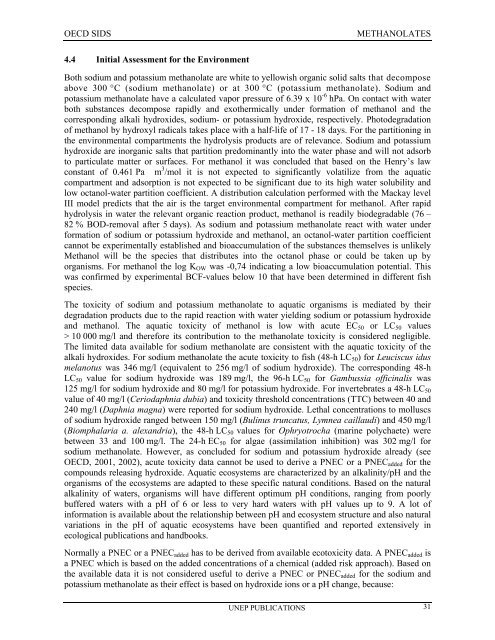Sodium methanolate - ipcs inchem
Sodium methanolate - ipcs inchem
Sodium methanolate - ipcs inchem
You also want an ePaper? Increase the reach of your titles
YUMPU automatically turns print PDFs into web optimized ePapers that Google loves.
OECD SIDS<br />
METHANOLATES<br />
4.4 Initial Assessment for the Environment<br />
Both sodium and potassium <strong>methanolate</strong> are white to yellowish organic solid salts that decompose<br />
above 300 °C (sodium <strong>methanolate</strong>) or at 300 °C (potassium <strong>methanolate</strong>). <strong>Sodium</strong> and<br />
potassium <strong>methanolate</strong> have a calculated vapor pressure of 6.39 x 10 -6 hPa. On contact with water<br />
both substances decompose rapidly and exothermically under formation of methanol and the<br />
corresponding alkali hydroxides, sodium- or potassium hydroxide, respectively. Photodegradation<br />
of methanol by hydroxyl radicals takes place with a half-life of 17 - 18 days. For the partitioning in<br />
the environmental compartments the hydrolysis products are of relevance. <strong>Sodium</strong> and potassium<br />
hydroxide are inorganic salts that partition predominantly into the water phase and will not adsorb<br />
to particulate matter or surfaces. For methanol it was concluded that based on the Henry’s law<br />
constant of 0.461 Pa m 3 /mol it is not expected to significantly volatilize from the aquatic<br />
compartment and adsorption is not expected to be significant due to its high water solubility and<br />
low octanol-water partition coefficient. A distribution calculation performed with the Mackay level<br />
III model predicts that the air is the target environmental compartment for methanol. After rapid<br />
hydrolysis in water the relevant organic reaction product, methanol is readily biodegradable (76 –<br />
82 % BOD-removal after 5 days). As sodium and potassium <strong>methanolate</strong> react with water under<br />
formation of sodium or potassium hydroxide and methanol, an octanol-water partition coefficient<br />
cannot be experimentally established and bioaccumulation of the substances themselves is unlikely<br />
Methanol will be the species that distributes into the octanol phase or could be taken up by<br />
organisms. For methanol the log K OW was -0,74 indicating a low bioaccumulation potential. This<br />
was confirmed by experimental BCF-values below 10 that have been determined in different fish<br />
species.<br />
The toxicity of sodium and potassium <strong>methanolate</strong> to aquatic organisms is mediated by their<br />
degradation products due to the rapid reaction with water yielding sodium or potassium hydroxide<br />
and methanol. The aquatic toxicity of methanol is low with acute EC 50 or LC 50 values<br />
> 10 000 mg/l and therefore its contribution to the <strong>methanolate</strong> toxicity is considered negligible.<br />
The limited data available for sodium <strong>methanolate</strong> are consistent with the aquatic toxicity of the<br />
alkali hydroxides. For sodium <strong>methanolate</strong> the acute toxicity to fish (48-h LC 50 ) for Leuciscus idus<br />
melanotus was 346 mg/l (equivalent to 256 mg/l of sodium hydroxide). The corresponding 48-h<br />
LC 50 value for sodium hydroxide was 189 mg/l, the 96-h LC 50 for Gambussia officinalis was<br />
125 mg/l for sodium hydroxide and 80 mg/l for potassium hydroxide. For invertebrates a 48-h LC 50<br />
value of 40 mg/l (Ceriodaphnia dubia) and toxicity threshold concentrations (TTC) between 40 and<br />
240 mg/l (Daphnia magna) were reported for sodium hydroxide. Lethal concentrations to molluscs<br />
of sodium hydroxide ranged between 150 mg/l (Bulinus truncatus, Lymnea caillaudi) and 450 mg/l<br />
(Biomphalaria a. alexandria), the 48-h LC 50 values for Ophryotrocha (marine polychaete) were<br />
between 33 and 100 mg/l. The 24-h EC 50 for algae (assimilation inhibition) was 302 mg/l for<br />
sodium <strong>methanolate</strong>. However, as concluded for sodium and potassium hydroxide already (see<br />
OECD, 2001, 2002), acute toxicity data cannot be used to derive a PNEC or a PNEC added for the<br />
compounds releasing hydroxide. Aquatic ecosystems are characterized by an alkalinity/pH and the<br />
organisms of the ecosystems are adapted to these specific natural conditions. Based on the natural<br />
alkalinity of waters, organisms will have different optimum pH conditions, ranging from poorly<br />
buffered waters with a pH of 6 or less to very hard waters with pH values up to 9. A lot of<br />
information is available about the relationship between pH and ecosystem structure and also natural<br />
variations in the pH of aquatic ecosystems have been quantified and reported extensively in<br />
ecological publications and handbooks.<br />
Normally a PNEC or a PNEC added has to be derived from available ecotoxicity data. A PNEC added is<br />
a PNEC which is based on the added concentrations of a chemical (added risk approach). Based on<br />
the available data it is not considered useful to derive a PNEC or PNEC added for the sodium and<br />
potassium <strong>methanolate</strong> as their effect is based on hydroxide ions or a pH change, because:<br />
UNEP PUBLICATIONS 31
















